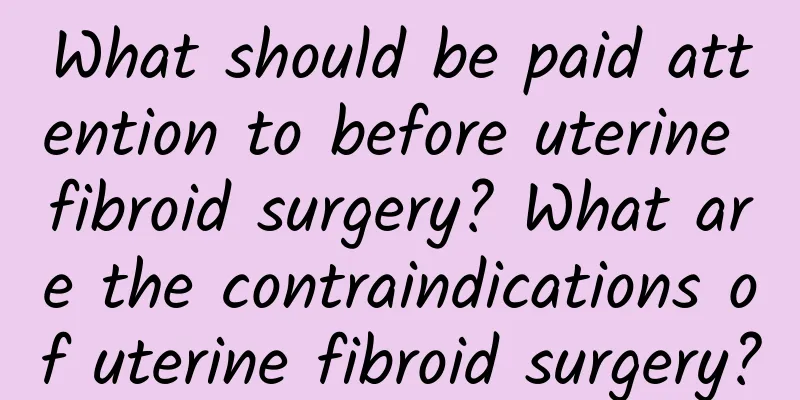What gynecological diseases are likely to occur after abortion? How can women prevent gynecological diseases after abortion?

|
Abortion is a commonly used method to terminate pregnancy. We do not recommend that you perform this operation frequently because it is very harmful to women's health. If you need to terminate the pregnancy due to an unexpected pregnancy caused by contraceptive failure, female friends must take measures to prevent gynecological diseases after the operation. Nowadays, people will resort to abortion to solve the troubles caused by unexpected pregnancy. But is the painless abortion really painless? It is not like that. Painless abortion only means that there will be no pain during the operation. Many women still have to endure pain after the abortion. After the abortion, the body of a woman is very fragile. At this time, the body needs extra care. If a woman does not do a good job in this regard, it is very easy for her to be infected with other gynecological diseases. Speaking of abortion surgery, do you know what common gynecological diseases women may experience after an abortion? Below, the experts from Love Gender will introduce you to this aspect. 1. Pelvic inflammatory disease, adnexitis, acute and chronic pelvic inflammatory disease, and endometriosis are common gynecological diseases after abortion: irregular menstruation, dysmenorrhea, distension and pain in the lower abdomen on both sides, increased leucorrhea, easy fatigue, and those with a long history of the disease will suffer from physical weakness, general discomfort, insomnia, etc., which will lead to adhesion and occlusion of the fallopian tubes, and may cause infertility. 2. Common gynecological diseases after abortion include dysmenorrhea: Some women have cramping pain or persistent pain in the lower abdomen before and after menstruation, accompanied by nausea, vomiting, backache, breast swelling, and even fainting in severe cases. This disease is called dysmenorrhea. Dysmenorrhea is more common in unmarried women at the beginning of menarche. Due to endocrine disorders or uterine hypoplasia, it causes severe pain in the uterus, narrow cervical canal, poor menstrual blood flow, and pain. Another reason is mostly caused by chronic pelvic inflammatory disease, uterine fibroids, uterine malposition, endometriosis and other diseases. The onset of pain is often closely related to the patient's physique and physical state, and dysmenorrhea symptoms cannot be ignored. 3. Common gynecological diseases after abortion include cervicitis and cervical corruption: yellow purulent leucorrhea, fever and dull pain in the lower abdomen, increased discharge, sometimes bloody or with blood streaks, or with a foul odor, sometimes enlarged uterus with tenderness, and persistent pain on both sides of the lower abdomen or the entire lower abdomen. When the inflammation develops to a severe stage, it can affect the myometrium and become myometritis, and can also cause ascending infection of pathogens. How to prevent gynecological diseases after abortion? Find out whether there are trichomonas and fungi in the vagina. If necessary, check for chlamydia, mycoplasma, and gonococci. If the above microorganisms are present, it is easy to cause ascending infection. Anti-infection and anti-inflammatory treatment should be carried out before abortion. Check whether there is inflammation. If there are symptoms of inflammation, further examination and treatment are required. Generally, treatment is required before surgery to prevent inflammation from ascending. During the operation, the intensity of stimulation to the uterine opening and uterine wall (including pulling, dilating the uterine opening, scraping the uterine wall, etc.) should be reduced as much as possible, and the initial movements should be gentle. Having an abortion after an unexpected pregnancy can cause great harm to a woman's body and mind. Although it is not a major operation, in order to help yourself recover better and faster, you also need to learn and use postoperative care methods to protect your health and minimize harm. |
<<: How to reduce the harm after abortion? There are 5 major risk factors in abortion
Recommend
Is congenital absence of vagina basically infertile?
Congenital absence of vagina is an uncommon gynec...
Learn some key vaginitis prevention measures
Vaginitis is a gynecological disease that is diff...
What are the symptoms of chronic pelvic inflammatory disease?
Chronic pelvic inflammatory disease is a common d...
Taking a hot spring bath during menstruation and within 4 days before and after can cause vaginitis
Women can often soak in hot springs to maintain t...
Will a uterine cyst go away on its own?
Uterine cysts generally do not go away on their o...
Do you pay attention to the symptoms of ovarian cysts?
Ovarian cyst is a common gynecological disease. I...
What are the treatments for spontaneous abortion?
What are the treatments for spontaneous abortion?...
What are the symptoms of miscarriage just after implantation? What is the clinical course of late miscarriage?
What are the symptoms of miscarriage just after i...
What is vaginal candidiasis?
Vaginal candidiasis is a vaginal infection caused...
Snack bar, barbecue and hot pot are all available! Nutritionists explain how to reduce sugar intake, so you can easily reduce sugar intake when eating out
As mentioned at the beginning of Part 3, there ar...
How much do you know about the care of vulvar leukoplakia?
How much do you know about the care of vulvar leu...
Detox and lose weight in spring by eating 100-calorie, high-fiber sweet potato dishes
The ancients believed that among the four seasons...
What are the symptoms of bilateral polycystic ovaries?
What are the obvious symptoms of bilateral polycy...
How to conceive when menstruation is irregular
For women with irregular menstruation, their ovul...
Is Mirena good for treating adenomyosis?
Adenomyosis is a common gynecological disease. Th...









